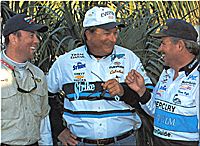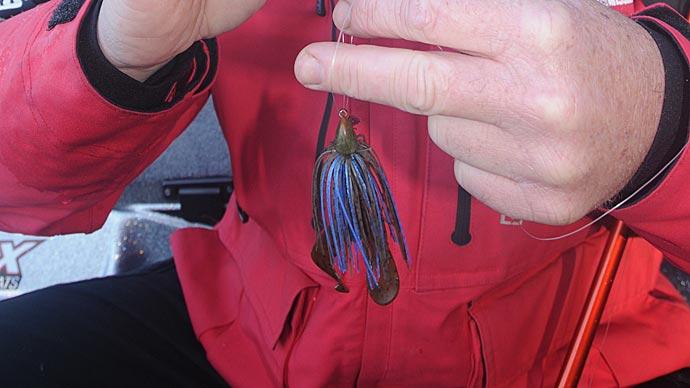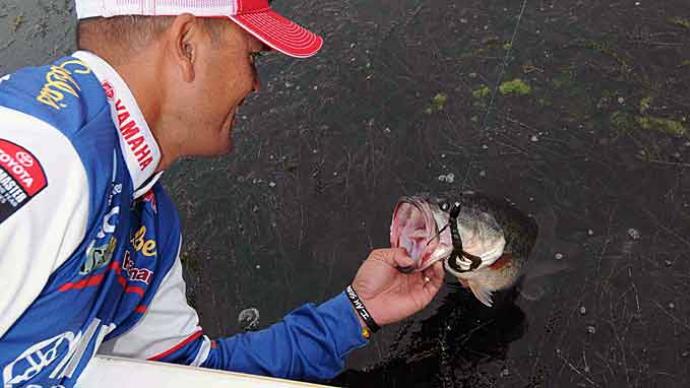
It has long been common knowledge that the skirted jig bags heavier bass on average than anything short of wild golden shiners and dynamite. Spinnerbaitsspinnerbaits, crankbaits, soft plastics, and topwater plugs take big fish, too. But when you leaf through the archives of significant bass tournaments, the jig stands alone in producing victories and a veritable mountain of cash.
With that in mind, every serious tournament angler should invest in an assortment of jigs, jig trailers, and stout rods -- including the mandatory flippin' stick. Even those who dote on other lures and tactics have no choice but to arm themselves with jig tackle. Avoiding doing so is like sending ground forces to combat an enemy with nuclear weapons.
When bass are on a jig bite, you had better be fishing this lure, or your odds of finishing high are slim to none. And even when bass prefer other lures, anglers who can eke out three or four bites a day with a jig still stand a good chance of finishing well.
"When the tournament limit is only five bass," says Kentuckian David Walker, FLW Angler of the Year, "you'd better be fishing for quality bites. That's what the jig delivers. I may catch only two bass on a slow day, but they'll often weigh more than a limit of fish caught with some other lure."
When you consider that many tournament anglers are proficient with jigs, how have anglers such as Walker, Denny Brauer, and Tommy Biffle managed to rise above the competition with these lures? One reason is they all belong to what could be called the "80 Percent Club." To qualify, you must fish jigs at least 80 percent of the time.
| "I fish a jig from shallow, muddy rivers to deep, clear reservoirs."-- David Walker, FLW Angler of the year |
In this age when "versatility" is the buzzword among most tournament anglers, relying heavily on a single lure appears to be a backward strategy. But the jig itself exudes versatility.
"I fish a jig," says Walker, "in everything from shallow, muddy rivers to deep, clear reservoirs. I fish it in cold or warm water, over clean bottoms, and in the thickest cover imaginable."
Denny Brauer, former FLW Angler of the Year and the first professional bass angler to have his image on a Wheaties box, believes too many anglers get hung up on versatility.
"You must be versatile," says Brauer, "but you must also master one technique. For me, that's jig fishing. When conditions are right for jigs, my chances for winning improve dramatically."
Put another way: If you become a jack of all bass fishing trades but a master of none, you're setting yourself up for mediocrity.
One key jig advantage is pinpoint accuracy when fishing dense cover. A flippin' or pitchin' presentation delicately drops jigs into tea-cup-size openings time after time. And when you penetrate a bass's lair precisely, you can soak a jig in place for whatever time is necessary to induce a strike. Yes, you also may soak soft plastic baits in a similar fashion, but you won't hook as many heavyweight bass.
When aggressive bass engulf jigs on the initial fall -- or after the first or second hop -- jig fishing experts make hay in a hurry. The problem with this circumstance is that even average jig fishermen catch bass. If the best cover is crowded with anglers, bass will likely be picked off ahead of you. That's why jig fanatics like Tommy Biffle often prefer a slow bite.
"Anybody," says Biffle, "can catch suicidal bass on a jig. But when bass bury in cover and are slow to bite, most guys fish too fast and never get a sniff. That's when I can fish right behind other anglers and still do well."
When Biffle senses his jig is in the cover that harbors a bass, he leaves the bait in place and counts how many times he has to work it up and down before he gets a strike. If the strike occurs on the 15th time he jigs or shakes the lure, he works it at least that many times in the next piece of cover. Should a bass swirl at the jig when he pulls it out of the cover, he extends his count at the next target.
"When you get in tune with one type of lure," says Walker, "you gain a sense of where it's going to work. So if I see a piece of cover in practice that looks ideal for a jig, say, a dock with planted brush around it, I won't bother fishing that spot. All I would do is possibly eliminate a bass I might catch in the tournament."
| "I think you'll see many more people casting 1-ounce jigs in the future."-- Denny Brauer, FLW Angler of the year |
This strategy paid off for Walker once while practice-fishing for an FLW tournament on Lake Murray, South Carolina. He checked an isolated windfall he had spotted in a pocket off the main lake. His depthfinder revealed that the outer limbs reached into 8 feet of water. The depth and the tree's isolation convinced him to return. He did so on the event's second day and duped a largemouth of nearly 6 pounds with his trusty jig.
When he does fish a jig in practice, Walker bends the hook over to avoid sticking bass. Many of the bass that spit out his jigs in practice inhale them again later when the money is on the line. This would not hold true if he hooked the fish in practice.
The drawback with fishing jigs in the shallow cover is that such places are visible to every other angler in the tournament. Even if the bass are on a slow bite, heavy fishing pressure will pick off some fish and make the others more difficult to catch.
"One thing I look for," says Biffle, "is a bank with no visible cover. Rocky banks warmed by the sun are good in the spring, especially those near deep water. When bass are on flats, the bank could be next to shallow water in the summertime."
When Biffle moves close and fishes "nothing banks," he often finds logs, stumps, and other cover beneath the surface that his competitors don't see when they run down the lake. The unharried bass relating to these spots eagerly snap up Biffle's jigs.
When armed with flippin' rods, Walker, Brauer, and Biffle rely mainly on 3/8- and 1/2-ounce jigs and 25-pound test lines. The 1/2-ounce jig gets the nod when penetrating thick cover and whenever bass react favorably to a fast sink rate. The 3/8-ounce size is for sparse cover and when bass demand a slower fall.
Walker opts for Gambler's Ninja Jig. Brauer ties on Strike King's Rattling Pro Model Jig. Biffle has done well with Rattle Back jigs. About 75 percent of the time, Brauer tips his jigs with Strike King's Rage Craw. Walker and Biffle, however, go primarily with plastic trailers.
"I used to use a lot of pork," says Biffle, "but it would sometimes roll over in front of the hook and cost me fish. So now I thread plastic crawdads onto the hook, and they work just as well, even in cold water. Biffle and Walker usually pinch an inch off the craw's tail to reduce the jig's profile.
Though they are noted for their proficiency with flippin' rods, Walker, Brauer, and Biffle frequently cast jigs when fishing deep. Typical targets include chunk-rock banks in clear water, sloping points, and river ledges where most other anglers employ crankbaits and Carolina rigs. All three of these jig fanatics cast with medium-heavy to heavy action 7-foot baitcasting rods.
Brauer casts the same 1/2-ounce Strike King Pro Model Jig he uses when flippin' but backs down to 12- to 15-pound line. When he wants to make longer casts to comb large bottom structures, he'll tie on a 1-ounce jig.
"I think," says Brauer, "you're going to see a lot more people casting 1-ounce jigs in the future."
Biffle only cuts back to 20-pound test when casting but will often drop to a 1/4-ounce jig when fishing rocky banks. "A 1/4-ounce jig," he says, "is not as apt to hang up in the rocks as a 3/8- or 1/2-ounce jig."
Walker may go as light as 10-pound test when casting a jig to clear-water bass. When using light line, he selects a 3/8- or 1/2-ounce casting jig, which features a thinner hook than on the Ninja jig. "When I cast a jig that has a heavy flippin' hook," says Walker, "I lose a lot of fish when they jump or suddenly change direction. A lighter hook grabs hold more easily and stays put, especially when I'm casting 10-pound line."
The jig's most endearing advantage is that its big bass appeal hasn't faded after decades of widespread use. Jigs are now fished throughout the seasons and in or over virtually every type of cover and structure bass relate to. So why haven't bass grown shy of this lure?
"Jigs resemble crawdads so closely," says Brauer, "that bass don't become conditioned to them like they do some other lures. So as long as bass feed on crawdads, they'll continue to be patsies for jigs.
Content provided by Bass Fishing Magazine, the official publication of FLW Outdoors




